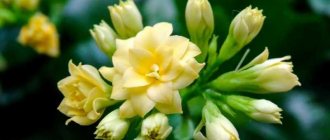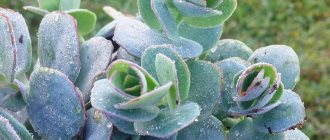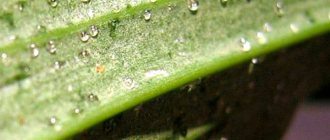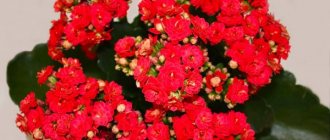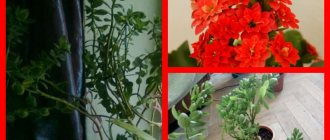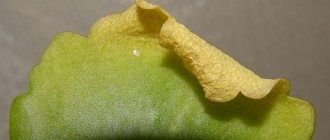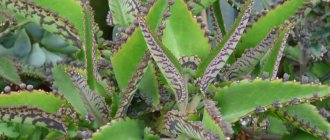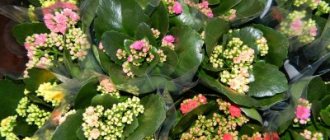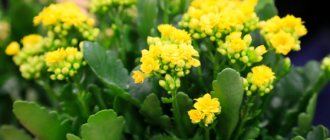Kalanchoe daigremontiana is a succulent belonging to the Crassula family. The birthplace of the flower is Madagascar. The succulent is popularly called viviparous. Since 1925, gardeners have been growing the plant as a houseplant. The main feature of Kalanchoe Degremon is that it is healing and can cure numerous ailments.
The plant is noticeably different from other species and varieties of Kalanchoe. Looking at the photo of Kalanchoe Degremon, you can see that the perennial succulent reaches 100 cm in height and has fleshy, elongated leaves. The leaves are green and dusty green in color, smooth to the touch with jagged edges.
Briefly about care
- Watering. In hot weather, Madagascar crops should be watered only after the top layer of soil has completely dried. In winter, the bush is watered approximately once a month.
- Illumination. The plant needs a significant amount of sunlight, however, on especially hot days, you need to shade the flower, otherwise it will dry out. During the cold season, the succulent should be kept on the south side of the windows, as the plant will not have enough natural light.
- Air humidity. This exotic plant loves dry air. Spraying the bush will be unnecessary.
- Temperature conditions. The air temperature should not be higher than 27 °C and lower than 12 °C.
- Bloom. A healthy plant blooms in winter with bell-shaped inflorescences of red or pink color.
- Trimming. After the crop has faded, it is necessary to remove the flower stalks.
- Transfer. A young plant must be replanted once a year. Adult specimens - as needed.
- Priming. The soil mixture should consist of sand and turf, leaf soil.
- Fertilizers. Fertilizers for succulents are used as top dressing.
- Reproduction. By cuttings and seeds.
- Diseases. Mold, rot, sunburn and powdery mildew.
- Parasites. Mealybugs, aphids and scale insects.
Kalanchoe Degremona is an undemanding plant that can be easily grown at home or in the country. Like all plants, Kalanchoe Degremona requires basic care at home. A healthy flower can please your household with beautiful blooms.
Possible problems in growing degremona
A mistake made by inexperienced gardeners is trying to force a succulent to branch. He is not capable of this. If you pinch the top of its head, this will lead to rapid extinction.
An equally common mistake is flooding. Excess moisture leads to rapid rotting of the roots. In such cases, only rejuvenation will help - completely cut off the lower part with the roots, and then root the crown.
Are there diseases and pests?
The following common pests threaten succulents indoors:
- aphid;
- spider mite;
- scale insect and false scale insect.
They are treated with acaricides and insecticides (Aktara, Iskra-M). If signs of a fungal disease are detected (brown or black dry or weeping spots on the leaves), it is best to rejuvenate the plant or treat it with a broad-spectrum fungicide.
Kalanchoe Degremona is a welcome guest in every home. A beautiful and medicinal plant does not cause any trouble, but will always provide the most valuable medicinal raw materials against diseases of the eyes, ears, nose, and colds.
Illumination
The southern plant loves sunlight. The flower can be kept on the windowsill on the east or south-east side. On especially hot days, Kalanchoe needs to be shaded and protected from the burning rays of the sun.
The sun's rays can cause the flower to burn - the leaves will turn yellow, begin to dry out and fall off.
In the winter season, the flower can be safely kept on the windows on the south side, and, if necessary, illuminated with special lamps.
Kalanchoe Degremona in a pot
Medicinal properties
Kalanchoe Degremona medicinal properties . The medicinal properties of Kalanchoe viviparous juice were discovered in the second half of the 20th century. Currently, the juice and pulp of the leaves are used on a large scale to produce medicines, creams and ointments. In addition, the plant can serve as a home doctor.
The juice of the flower is used to treat runny nose, flu and headaches.
Degremona is an unpretentious succulent , which, with proper care, will delight you with its appearance for a long time, and will also become a real assistant for the treatment of many diseases and ailments.
Bloom
Many plant growers are tormented by the question: when and how does Kalanchoe Degremona bloom? Kalanchoe Degremona usually blooms in the winter season. Therefore, pink cone-shaped flowers can be expected for the New Year or Christmas. And if your flower has bloomed, you will admire it from several weeks to several months.
Flowering Kalanchoe Degremona
Kalanchoe Degremona flowers
Diseases and pests
Kalanchoe is harmed by excessive sun rays, excess moisture and excessive feeding. It is necessary to monitor the condition of the root system so that it does not rot.
If this happens, you need to remove the affected areas and replant the succulent.
Of the parasites, the most dangerous is the scale insect, which causes a gray coating and fungus to appear on the leaves and stems.
Stains are removed with a brush, then the leaves are wiped with alcohol.
Mealybugs leave a white coating on the leaves. They are also removed with an alcohol solution.
When aphids appear, yellowing of the leaves is observed; the insects themselves are located at the bottom of the leaf. The plant is treated with laundry soap.
In addition, there are many pest control products that can be found in specialty stores.
Reproduction
Kalanchoe reproduces in several ways: by cuttings and seeds.
By cuttings
You can propagate shrubs using cuttings at any time of the year, but it is not recommended to do this during the flowering period or immediately after.
To make cuttings, you need to break off a branch of a bush and place it in a bottle with water. After the roots appear, you can plant the cuttings in the ground. The young plant is watered generously with water at room temperature.
Reproduction of Kalanchoe Degremona
Seeds
The seed propagation method is long and problematic. Seeds can be purchased at a flower shop or collected from the plant.
It is recommended to sow seeds in February or March.
The seeds need to be immersed in a soil mixture consisting of turf soil and sand. The soil must be moist. When planting, you do not need to bury the seeds in the ground, they should be on the surface. After planting, the container with soil must be covered with glass. The top of the glass must be covered with thick paper that will not transmit light. The seedlings should be ventilated daily.
Botanical description
Kalanchoe Degremona is a non-branching plant that grows with a straight stem up to a meter in height. The island of Madagascar is considered its homeland. Belongs to the Crassulaceae family, a species of the genus Kalanchoe. The leaf plates, triangular and fleshy, are folded in such a way that they resemble a boat with carved edges up to 20 cm long. In an adult plant, miniature bushes are formed along the carved edges of the leaves - brood buds, with the help of which this Kalanchoe reproduces, since the buds have their own root mass.
At the end of winter, specimens older than 5 years bloom with small drooping flowers. The length of the light buds is up to 2 cm.
In folk medicine, not only Kalanchoe degremona is used, but also Kalanchoe pinnata. The difference lies only in the appearance of the plant, since pinnate Kalanchoe has a less impressive body structure. But the chemical composition of the plants is the same.
In the photo Kalanchoe Degremona and its flowering:
When can you prune?
The question of the correct timing of pruning Kalanchoe is very important, because the health of the green pet largely depends on this. Florist specialists categorically prohibit performing the operation in winter, because, starting in November, the flower enters a state of hibernation - dormancy. It is necessary to catch the period from the end of winter until the beginning of Kalanchoe flowering, which occurs in late spring. Under no circumstances should you touch a flowering plant, even if you just need to trim the crown a little. The plant may drop its flower stalks and become sick. You'll have to wait until it blooms.
The best time of day for pruning is early morning or evening after sunset; it is not recommended to do the procedure closer to noon.
After transplantation, the plant cannot be pruned; it must be given time to adapt, about half a month. You should also wait 10-15 days after the pests on the diseased or damaged flower are completely destroyed.
Additional Information. To carry out the operation, you must use a disinfected utility knife (or garden pruning shears); tearing off leaves and shoots by hand can cause flower diseases and rapid withering.
A utility knife is the best tool for pruning Kalanchoe
Is it possible to prune in spring?
The best time to prune an overgrown Kalanchoe bush is mid-spring. The end of March, all of April and the beginning of May are perfect for different types of pruning
However, it is very important to ensure that the plant does not begin to throw out flower stalks and bloom at this time. When a new bush is planted, its stem and top actively stretch upward, so it is necessary to pinch it lightly without waiting for full foliage to grow
This operation will give the Kalanchoe a pleasant “rounded” appearance.
Kalanchoe – photo
Despite their specific appearance, Kalanchoes are also very diverse and attractive. Just look at the photo!
Photo: netgusevu.ru
Photo: build-experts.ru
Photo: landshaftadvice.ru
Photo: dom-zdorovia.ru
Photo: remontbp.com
Photo: sk-resultat.ru
Photo: pinterest.ru
Photo: pinterest.es
Photo: apriltime.ru
Photo: yellowhome.ru
Photo: ecobeltex.ru
Photo: zhenskietainy.ru
Photo: 7dach.ru
Photo: domopravitelnitsa.com
Photo: wallbox.ru
Photo: rasfokus.ru
Photo: mrfilin.com
Photo: greenlabco.ru
Photo: zen.yandex.ru
Photo: hubpages.com
Photo: o-flora.com
Photo: build-experts.ru
Photo: elhorticultor.org
Photo: fairyinagarden.com
Photo: 2sotki.ru
Photo: tr.tricornmedals.com
Photo: erdus.club
Photo: 2sotki.ru
Did you like the post? Subscribe to our channel in Yandex.Zen, it really helps us in our development!
Types of Kalanchoe
Kalanchoe can look so different that it is difficult to classify two flowerpots as the same genus. And all because there are about 200 varieties in the world. True, only a few of them are usually grown at home.
Kalanchoe Degremona
The variety is not decorative at all, but it is what they first of all mean when they talk about medicinal Kalanchoe. The succulent reproduces easily, because its “babies” grow directly on the leaves, and in large quantities.
Photo: udec.ru
Kalanchoe Blossfeld
The compact ornamental bush blooms with bright umbrella-inflorescences. This same variety includes the very popular Kalandiva series with voluminous double flowers.
Photo: 2sotki.ru
Kalanchoe dissected
Spectacular long shoots are densely covered with narrow leaves of dissected type. Due to its characteristic appearance in everyday life, such Kalanchoe is called “deer horns”.
Photo: pinterest.ru
Kalanchoe pinnate
Another medicinal variety is propagated in the same way by “babies” on the leaves. The pattern of veins on the elastic leaf blades resembles feathers, which is how the name came about.
Photo: attuale.ru
Kalanchoe Mangina
This is a decorative ampelous variety that blooms with scarlet bells. And it also reproduces by “babies”, because it belongs to the so-called bryophyllums.
Photo: sueveriya.ru
Kalanchoe tubiflora
And again another bryophyllum in the rows of Kalanchoe, but this time it can be called decorative. And all because its plates are intricately wrapped into tubes.
Photo: planteset.com
Kalanchoe: home care, propagation and transplantation


